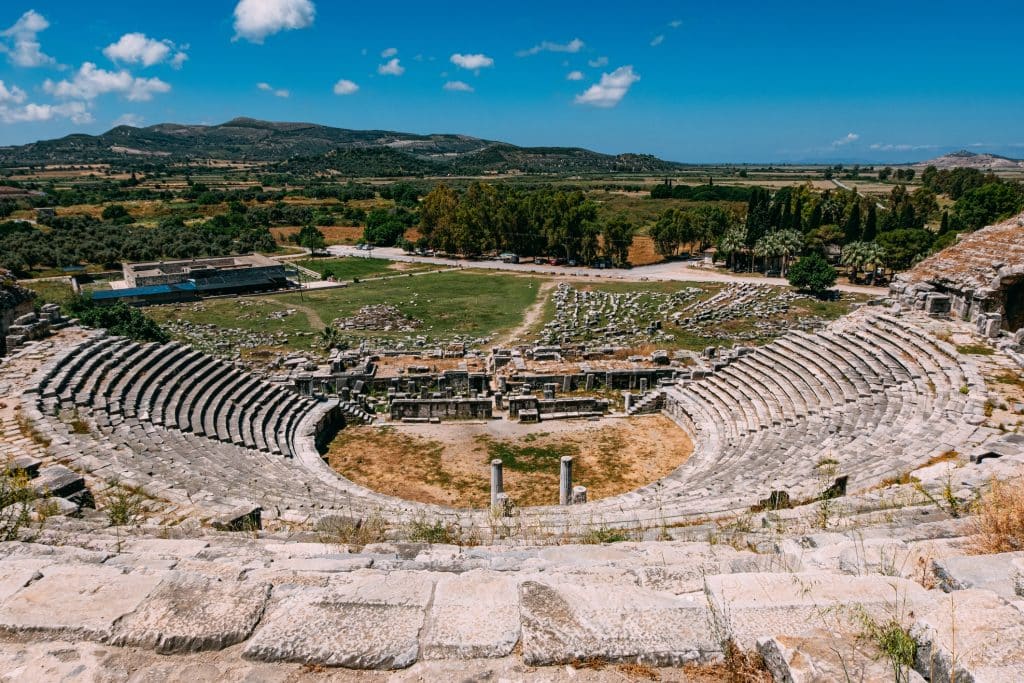Stately, yet charming: Aspendos!

First on the list, of course, is Aspendos. This magnificent theater was – and still is – a showpiece in Aspendos Ancient City. Built by the architect Zenon while under Roman dominion, Aspendos Theater has a capacity of 15,000 people. As one of the best-preserved ancient theaters, the Aspendos Ancient Theater is the oldest and strongest example of Roman-era theaters. Its structure incorporates a semi-circular stone floor for smaller audiences, but even the softest sounds from the stage are audible from the highest rows. Aspendos, which is visited by thousands of tourists every year, is still used for concerts and other events.
A holy stage in a holy city: Hierapolis

The theater stage of Hierapolis Ancient City, in Denizli, is considered among the most beautiful existing structures remaining from the Roman era. The construction of the 1,800-year-old Hierapolis Ancient Theater, which has 50 seating rows, began in the second half of the 1st century and took about 150 years. One of the most monumental elements of the stage are its marble reliefs, depicting a series of mythological events and stories. Hierapolis Ancient Theater is also the first ancient theater in Türkiye with a restored stage; the theater continues to host cultural and artistic events with a capacity of 12,000 people.
Pergamon: Standing upright!

Pergamon Ancient Theater is the world’s steepest theater with an angle of about 70 degrees. But all those steps are worth climbing, because the 10,000-seat theater, built on the slope west of the Temple of Athena, has a magnificent view of Bergama. Another interesting fact: A collapsible wooden stage was used for certain performances. Unfortunately, this stage has not survived but, if you come to Izmir, ascend to the top of the Pergamon Theater and observe the stunning view.
Milet: A visit to the New Stone Age

Our next long-standing theater is in the Ancient City of Miletos in Aydın’s old port area, where the first settlement remains date from the New Stone Age. The Theater, which is 30 meters high is a typical example of Greco-Roman architecture; its capacity rose from 5,300 people during the Hellenistic period to 19,000 during the Roman era. Today, the remains of a castle used in Byzantine and Ottoman times are on the third floor of the theater. The parts of the stage that have survived to this day, and the galleries between floors, retain that theatrical atmosphere. If you don’t visit Miletos, the city of philosophers and legends, you will not have completed your tour of the ancient theaters in Türkiye.
Antiphellos: And on stage, the sea you can take

The Lycian-era Antiphellos Theater is in Antalya’s Kaş district and, fittingly, has a wonderful view of the sea. Just a short walk from the center of Kaş, sunset is the preferred time to visit the theater, which seems to have been constructed solely to showcase the natural view: there are seating areas facing the sea, but no stage. One can’t help but wonder if, perhaps, Antiphellos Theater was actually built so that the town’s 4th-century population could watch the sunset from the best angle.
Aphrodisias: By chance…

The story of the ancient theater in Aydın is interesting, Ara Guler, a famous Turkish photographer, goes to the area to take some photos, gets lost and finds himself in the middle of the ruins. When the excavations of the ancient city began in the early 1960s, the residents of Geyre village, which was built atop the theater, were moved to their new home in Yeni Geyre village. Subsequently, this gorgeous theater was discovered and excavation began in 1966. In addition to the preserved part of the theater and numerous sculptures and reliefs, there are many valuable works of art, including temples and the magnificent theater dedicated to Aphrodite, the goddess of beauty and love.
The largest in the world: Ephesus Ancient Theater

Ephesus Ancient City features the largest open-air theater in the world and is a valuable cultural asset of our country. Ephesus Ancient Theater, built in the Hellenistic period, was used for gladiator exhibitions, festivals and St. Paul’s sermons. Today, the most famous orchestras in the world perform amid the unique acoustics of the Ephesus Theater. It has a capacity of 24,000 people; while the three-floored stage has been demolished, the remaining sections have survived to this day.
As well, the universal symbol of theatre – the crying/smiling masks – originated here, when actors expressing political discourse began using masks to conceal their identities. The world’s most monumental open-air theater, featuring countless stories and eons of applause, is right in front of you!
A finely crafted masterpiece: Priene

Priene Ancient City in Aydın is considered one of the best early examples of city planning in the world. The theater, which was built 2,500 years ago by applying mathematics calculations for the first time, is a 50-row structure with a capacity of 5,000 people. Despite alterations during the Roman era, the front of the theater features an imposing temple dedicated to the goddess Athena, preserving the Hellenistic tradition. This prehistoric stage built on the slopes of Dilek Mountain is one of the most well-preserved examples of its period. Instagrammers will love the rock-carved, throne-like seats!
Stories knock at your door!
You can easily download images, and share on your social media accounts via your smartphone. Just press and hold the story, and save or share the image you have selected via the menu that appears.




